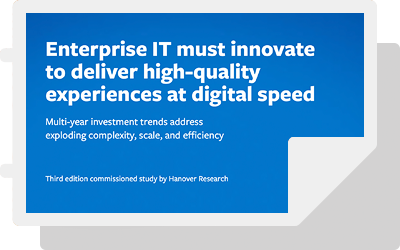Companies have learned from the business changes hastened by the pandemic that they must continue to drive modernization across data and business processes to meet needs of the always-on, increasingly digital-first economy. One foregone conclusion is that siloed, traditional IT service management and operations management (ITSM-ITOM) tools and processes are falling short in delivering the necessary speed, agility, and automation to remain competitive.
When service management and service operations functions exist and operate independently of one another across the enterprise, they result in limited capabilities and require manual, more labor-intensive efforts. Moreover, the integrations often required to bridge their respective functions are also manual, time-consuming, and expensive, which is further complicated by the proliferation of data, applications, and architectures spanning multi-cloud, data centers, mainframe, and the edge.
So, what is the answer? ServiceOps, commonly defined as the merging of service management and operations management, is an approach gaining traction with companies as part of their digital transformation journeys. According to a recent Hanover Research study commissioned by BMC, 73 percent of those surveyed currently combine ITSM-ITOM functions into a single centralized team for incident management (63 percent), problem management (62 percent), and service resolution (59 percent), with two-thirds well on their way to full integration.
What is BMC’s Approach to ServiceOps?
BMC’s approach to ServiceOps is rooted in the BMC Helix platform, with artificial intelligence (AI) and machine learning (ML) at its core. It’s a complete, integrated software-as-a-service (SaaS) digital transformation engine that converges ITSM-ITOM and modernizes processes and workflows for both teams, empowering organizations to accelerate DevOps; leverage intelligence for faster, better decision-making; and strengthen collaboration.
Additional benefits include:
- Unifying data and workflows throughout hybrid cloud environments, minimizing manual, repetitive processes, and increasing the speed to desired business outcomes
- Spending less time reactively responding to incidents and proactively resolving them before they impact the business through integrated cross-platform AI/ML, intelligent automation, and predictive service management in concert with other BMC Helix solutions
- Automating processes and reducing silos to foster collaboration across IT, lines of business, product teams, and customers
In market and ready to deploy now, ServiceOps enabled by BMC Helix is already paying dividends for our customers.
BMC Helix makes it easy to start your ServiceOps journey now. With a ServiceOps approach, you can accelerate new product development, time-to-market, and revenue growth; activate, deliver, and manage always-on products or services; and rapidly reduce the number and impact of incidents—and their corresponding business risk. All of that helps improve the customer experience, and customer retention, which then improves profitability, too.
Learn more about how a ServiceOps approach and BMC Helix can help you achieve desired business outcomes and adapt to market changes faster—starting today—at bmc.com/serviceops.







